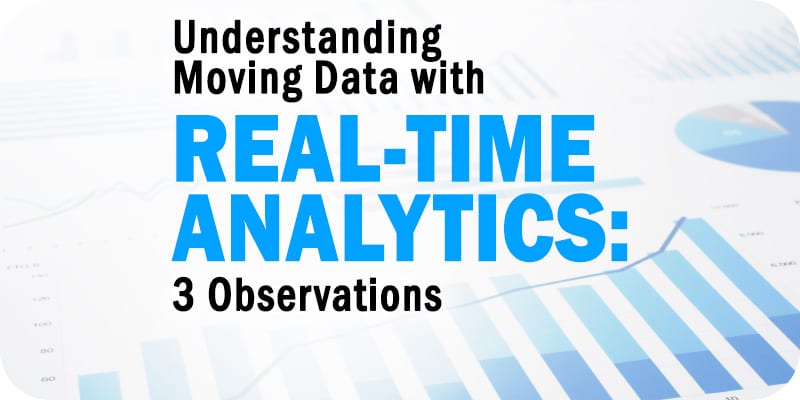Understanding Moving Data with Real-Time Analytics: 3 Observations


This is part of Solutions Review’s Premium Content Series, a collection of contributed columns written by industry experts in maturing software categories. In this submission, TIBCO Software Senior Vice President of Analytics, Data Science and Data Virtualization Mark Palmer outlines some key observations when it comes to real-time analytics.
 Businesses invest in a hoard of resources and budgets to analyze static data. From finances to customer preferences, analytics is a key part of using data. However, what about data that is constantly changing and in motion?
Businesses invest in a hoard of resources and budgets to analyze static data. From finances to customer preferences, analytics is a key part of using data. However, what about data that is constantly changing and in motion?
Data from sources like social media, log files, production monitors (think energy facilities/oil rigs), and medical devices are constantly updating and changing in real-time. The ability to analyze real-time data is crucial for companies, and necessary to keep businesses competitive. With the rise of IoT and ever-increasing data from customer interactions streaming across the enterprise in the last year, the ability to accurately capture data in motion leads to an increase in business growth.
Understanding Moving Data with Real-Time Analytics
Data-in-Motion is Mission-Critical
So, how does data in motion help businesses? Data in motion is critical to making decisions that demand speed. When businesses need to react quickly to a situation, the ability to analyze data in real-time is crucial. It can have a lasting impact, especially in mission-critical situations where a split-second change in data.
For example, when monitoring production systems for an oil rig, the business intelligence dashboard refreshes every 30 minutes. If there is an alert that one of the pump’s temperature and pressure is spiking, meaning the pump is damaged, the information is old and production is already stopped. Having the ability to not only capture data in motion but analyze it accurately and quickly can prevent major production losses as they arise.
Automation is Powering Real-Time Data
Business today is becoming more automated. Oil rigs, energy plants, and industrial equipment automate manual jobs. Weather scientists use real-time weather forecasts to anticipate and plan for natural disasters. Clothing stores and retailers monitor and react to social media sentiments in real-time. All of these functions require analyzing data in motion.
For example, CAF, a company that makes, maintains, and operates trams, metros, commuter, and high-speed trains, leverages data generated by their trains to create a more seamless experience for passengers. CAF’s digital service branch uses their LeadMind digital monitoring solution, which automatically detects how many passengers are in each coach and sends real-time information to the next stop, so riders can choose which car to sit in. By analyzing their real-time data, they are able to improve the overall customer travel experience.
Fulfilling the need for real-time analysis is difficult, as it demands data that is constantly changing – in some cases, the data can change hundreds of times within a second. Though a common solution to analyzing and tracking data in-motion is storing the data in a database, the most valuable part of real-time data is lost: the context, the motion, and rate of change. As automation becomes even more of a reality, it is critical that businesses understand the data generated by these automated processes and how to capitalize on the insights to impact their bottom line.
The Secret is in the Visualizations
Analyzing data in motion also provides businesses with a crucial tool – real-time data visualization. When data is analyzed visually, businesses are allowed to understand large amounts of data much faster than if they were in spreadsheets. And with more modern solutions and capabilities, users can even visualize data in real-time.
Being able to analyze and view the changes in real-time data, both internal and external, can provide valuable insight into maximizing gains and minimizing losses. Seeing trends in real-time data allows organizations to make decisions based on accurate and timely facts instead of assumptions.
Since visualizing data makes the data accessible and easily digestible, real-time data visualization allows for fast analysis and action. Furthermore, users can also transform the data into desired configurations. Overall, real-time data visualization allows organizations to unlock the true value of their data and use this to make quick and efficient decisions.
Analytics on data in motion helps reveal what had been invisible. Continuous context helps knowledge workers put what’s happening now in perspective, within minutes. It helps them make new comparisons. Though streaming analytics is in its infancy, real-time data is essential as all businesses shift to becoming more digital and automated. So, welcome to the moving data analytics era.































